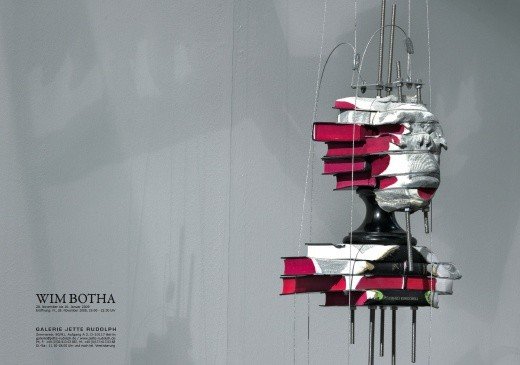Wim Botha
dal 27/11/2008 al 9/1/2009
Segnalato da
27/11/2008
Wim Botha
Galerie Jette Rudolph, Berlin
The visual language of Botha's two- and three- dimensional objects assembles a world of references and symbols into a narrative, architectural concept, fed by sophisticated drawings and large-scale prints, mirrored and sculptural ensembles. They are installed likewise opposing positions into an encompassing space of subjectivism and objectivism, spirit and nature.

"We must adapt to the idea, that each visible is carved from the tangible one, to a certain extent that each tactile is earmarked to the visibility (…)" - "As if the act of seeing would always end in the tactile investigation by an imaginative founded plane by ourselves (…). We must close our eyes, in order to see (…)."
(free translation from: Was wir sehen blickt uns an. Die Metapsychologie des Bildes; George Didi-Hubermann, Finkverlag, München 1999)
For his first solo show in Berlin we are proud to present the South African artist Wim Botha (b. in 1974 Pretoria based in Cape Town) after his successful appearance with the installation "Vanitas Toilette" at the Art Forum Berlin in 2008.
The visual language of Botha´ s two- and three- dimensional objects assembles a world of references and symbols into a narrative, architectural concept, fed by sophisticated drawings and large-scale prints, mirrored and sculptural ensembles. They are installed likewise opposing positions into an encompassing space of subjectivism and objectivism, spirit and nature, the correlation of the aesthetic ideal and human fallibilities.
The exhibition space is coloured, also metaphorically, in black and white– could be seen as references to the underlying motif of duality, of ambiguity and contradictions- thesis and antithesis. By typical ceiling suspensions of Botha´ s objects via steel cables the provoked meanings lose ostansible their traction combined with their respective assignments. Meanwhile formal recourses to the South African architecture and furnishing, also Calvinist coined church interior are made; hovering pillars made from black coloured wood are partially mirrored, a coffin-like bathtub, frames with golden edges, naturalistic drawings of animal skull studies, the paper busts carved from bibles representing the black, white and cardinals red. Like the coordinates of the space the whole installation becomes an epic narration by adding x plus y plus z: iconic and heraldic symbols, animal fables and depictions of stereotypic men, even the matter of the works deals with the question of power, religion, ideology and caducity as well as a scene-graphic mirror of societies and communities and the role of the individuals in-between.
Botha´ s drawings are arranged to show human characteristics, all-in they give us some hints about the ambiguities in their different cultural using- they sing a canonical sinister music piece, addressed and answered by one of the busts, presented with wide open mouths.
E.g. the python as a symbol for the Evil in Christian language, but also as the symbol for lore in Asian mythology; the Zulus (a South African ethno group) believes in the python as an ancestor, and even in ritual dances lay the depiction of man and woman, the obedience of woman to the man. It is a magical animal and killing a python during the rainy season would result to the end of nourishment and the end of the clan - it is the archaic symbol for men´ s sexuality. The drawings are bounded in-between the architectural frame, which acts on this suggestion of a whole organism. The question of men and their self-perception, to be autonomic, believing to be the final instance to God, to the Divine leads into the agitation of self-determination by the question of caducity.
By the artist´ s large-scale prints, e.g. "Saturn" close to the ancient god Uranus, the depiction of the mythological subject of the deities of the sky as well as the Christian symbolism of the trinity is suggested. The passage of time is also emblematised by the ancient god Janus, he is the god of the doors, entry and exit, birth and death, seasons of the year, double faced to look back- and forward, there lays another ambiguity. Titian used this type of depiction in his image "allegory of the prudence" about the three ages of men ("ex praeterito, praesens prudenter agit, ni futura actione deturpet"- “the present acts prudent of the knowledge of past, to avoid derogation in future”). By using this connection the old demand about death and the passion of the men is evoked, as the eldest mystery of the world until now with an open end, it deals with the deepest fears and wishes and the desire to extravagate.
The organism of the installation creates a face of a world; by using the haptic sense colours, lines, planes, also the materials –paper, glass, wood and water– as well as the visual image language of historical and contemporary resources the work gains an individual apperception based on methodology and allegory.
Galerie Jette Rudolph
Zimmerstrasse 90-91 - Berlin
Free admission



